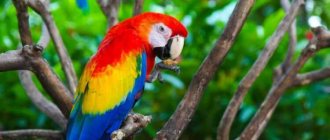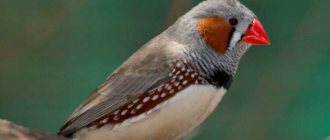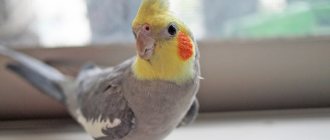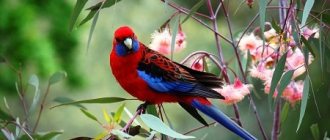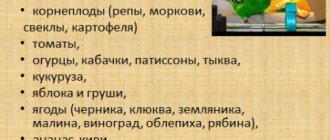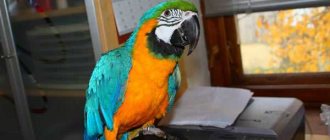Large parrots
Large birds include birds with a body size of 45–70 cm and a mass of 1–4 kg. A large, luxurious individual will become dear to the owner in all areas: the purchase price, the cost of maintenance and treatment, disagreements with others (neighbors and family members). All types of parrots have intelligence, but the larger ones are distinguished by their tenacious mind and remarkable abilities. If you manage to establish contact in a pet-human pair, then the bird will respond to your care with sincere affection and become your best friend.
Amazon is a cheeky trickster
Amazon is a green parrot with small colored spots on the body: neck, shoulders, wings, head. The bird is stocky, squat, with a short tail and a rounded, sharp beak. The natural habitat of birds is the Amazon River basin with impenetrable tropical forests. The classification includes 30 types of Amazons, but no more than ten of them are suitable for home keeping.
This is interesting! Amazons are conservative and do not take well to change. Unusual toys are avoided, as is unfamiliar food. True, there are usually no problems with adaptation and taming.
The shortest and most succinct description of Amazon is “urban hooligan.” He is incredibly inventive: it is impossible to predict what trick he will come up with next time. He knows how to pretend and knows how to lure forbidden food from his owner. If a direct request does not work, the bird will perform a roundabout maneuver, but will achieve its goal. Loves attention, does not hang out in the company of strangers. He is very emotional and does not consider it necessary to restrain his feelings. Shows both joy and dissatisfaction equally loudly. Can speak clearly and articulate well.
Cockatoo - crested intellectual
In nature, the cockatoo lives on the Pacific Islands, New Guinea and Australia. The following varieties of parrots are popular among members of the family:
- Goffin's cockatoo;
- Alba's Great White-crested Cockatoo;
- greater yellow-crested;
- pink.
A large bird with a proportional body, strong limbs and wings, and a massive beak. The peculiarity of the cockatoo is the lush crest on its head: when folded, it reaches a length of 20 cm, and when unfolded, it forms a kind of crown.
Attention! Children should not be left unattended near cockatoos. Even in a cage, an aggressive and jealous pet can cause serious injury to a child.
The domesticated cockatoo is artistic and playful. She dances well, singing along and keeping in time with the music. He loves to cuddle with his owner, placing his head on his shoulder and exposing his wings for stroking. The parrot has enviable intelligence and is easy to train and learn. He is able to remember and reproduce hundreds of words and short phrases. A lively, active mind does not allow the bird to get bored, forcing it to look for any available means of entertainment. With its powerful beak, the bird destroys everything around: it bites through wires and rods, tears off the leaves of indoor plants, destroys upholstered furniture and wall decoration. Sudden changes in mood are normal for cockatoos: from the state of an affectionate kitten to an angry fury.
Kakapo - flightless parrot
A rare species of parrot, native to New Zealand, looks like an owl, which is why it received its second name - owl. His wings are weak, so he cannot fly. It moves easily and quickly with the help of wide, flattened paws. Nature has provided camouflage coloring for the kakapo: its feathers are dark green with speckles.
Like owls, kakapos are nocturnal. Having waited until dusk, the heavy bird emerges from its hiding place and goes in search of food. In the dark, he orients himself by smell, since the sense of smell is well developed, unlike vision. Vibrissae-like feathers grow around the beak, which help to better sense space. When danger is detected, the bird freezes in place, remaining completely motionless.
On a note! Keeping a kakapo in an apartment is impossible: inactivity and monotonous surroundings have a detrimental effect on the exotic bird. Parrots of a unique species are bred in captivity on special farms only to restore the population.
The kakapo eats incessantly, because it does not need to preserve its graceful body shape for flight. Thanks to this feature, the parrot looks like a pig: it even grunts as it picks berries and fills its enormous stomach with them. The kakapo's way of feeding is interesting: it uses its beak to grab the soft part of plants, chew it, and draw out the juice. You can tell from the fibrous clumps left on the grass that this was a kakapo pasture.
Kea is an unceremonious character
You can meet kea, an original species of parrot, only on one of the islands of New Zealand. The harsh mountain climate of the South Island is ideal for this unusual bird. Externally, the kea looks more like a raven than a parrot: it has a flat head, a sharp elongated beak, and brown feathers. When it takes off, the orange, fiery underside of its wings is exposed.
This is interesting! The Nestors received the nickname “sheep killers” from people. It is known that kea, in times of hunger, attacked weakened animals, pecking at the skin, extracting subcutaneous fat. Some sheep died, and the predatory kea fell into disrepute and endured several decades of mass extermination.
With its hooligan behavior, kea deserves conflicting reviews. A bird of this species not only comprehends what is happening, but also knows how to turn the course of events in its favor. For example, the best entertainment for nestors is playing pranks on tourists:
- A flock of feathered pranksters on the roof of a tourist house is tracking down a victim. Noticing the approach of a person, the birds give a signal to their leader, who dumps snow and ice on the poor fellow’s head.
- Parrots make predatory forays into unlocked houses. They get inside through a door or window, destroy travel equipment, electronics, and open duffel bags.
- Cheeky birds fearlessly walk around campsites, overturning containers and scattering trash. They damage cars: they tear off wipers, seals, break mirrors and headlights.
Macaw - a spectacular giant
Majestic birds of gigantic size live in Central and South America. They live in flocks near wetlands or river banks. The macaw is the largest breed of parrot: its body length reaches 60–70 cm, and its tail feathers grow up to half a meter. An adult weighs 1 – 1.5 kg. The plumage contains bright shades of different colors, depending on the species. The most common are the red macaw, the blue-yellow macaw, and the green-winged macaw. The largest is the hyacinth macaw, very beautiful and extremely expensive.
Important: to have such a large bird at home, you need to allocate an entire room for it. The parrot will spend most of the day wandering freely, and when feeding and sleeping, it will climb into the enclosure.
Advantages of the macaw:
- Quite smart birds cannot live without constant brain activity. To develop their minds, they need various puzzles, toys and entertainment;
- They become strongly attached to their owner and remain loyal for a long time.
Disadvantages of the Macaw:
- have difficulty pronouncing words. The average reserve is ten words;
- demanding in content, need to move freely;
- picky about food;
- have an unpleasant harsh voice;
- They need all the attention of the owner, otherwise they can fall into a depressed state.
Small parrots
The most popular pet parrots are species such as lovebirds and budgerigars. The universal love for small birds is based on relatively small material costs. The unpretentiousness of small birds and low noise levels are also important. Owners experience special joy if their pets can pronounce words tolerably well.
Woodpecker parrot – green dwarf
The smallest representative of parrots lives in Indonesia: its length is no more than 10 cm, its weight is up to 15 g. The beak is narrow and curved. The plumage is predominantly green. The tail feathers form a shape similar to a woodpecker's tail - slightly rounded or almost straight.
It is very difficult for scientists to track woodpeckers in the wild. Therefore, tiny birds are extremely rarely kept in captivity. They do not eat grain feed, which is explained by their small size. The diet includes liquid products: nectar, fruit pulp, plant juice. Woodpecker parrots are not averse to snacking on insects, and occasionally feast on moss and tree resin.
The passerine parrot is a smart fidget
In the North-West of South America there lives a funny bird that looks like a sparrow. The wedge-shaped tail and head shape give it a resemblance to a feathered thief. But the colors of the plumage of a parrot and a sparrow are different: instead of brown and gray shades - green, blue, turquoise. An adult passerine weighs no more than 40 g, its body reaches only 15 cm in length.
On a note! Just because a bird is small does not mean it is quiet. Budgerigars vocalize non-stop. When several individuals chirp at the same time, it is hard to hear.
Keeping a passerine parrot at home is not difficult. Food intended for small bird species is suitable for feeding. The modest dimensions of the bird allow you to choose a small cage. However, experienced poultry farmers prefer not to house tiny parrots in separate cages. On the contrary, they unite them in large groups and place them in a spacious enclosure. These restless pets interact poorly with other species of birds in the same space, and even attack individuals that are larger in size.
The budgerigar is everyone's favorite
The most popular type of parrot for home keeping. Natural habitat is Australia, lifestyle is gregarious, nomadic. The bird grows up to 15 cm, its weight usually does not exceed 50 g. Natural color of plumage: green. A characteristic feature is a wavy pattern on the back of the head and back. Breeders have developed many mutation colors, including albinos.
Attention! You can buy a budgie at a pet store or from a private breeder at a price of 400 rubles. Exhibition specimens bred in a nursery are valued tens of times more expensive.
The budgerigar has other features:
- in the male, the feathers on the forehead fluoresce in ultraviolet rays;
- during mating games, the female and male perform the ritual of “kissing”;
- the parrot is able to turn its head 180 degrees;
- the bird can reproduce individual words, and does so with sufficient clarity.
Lovebird - a devoted friend
Africa and the island of Madagascar are the homeland of lovebirds. These small birds occupy second place in the world among feathered pets, second in popularity only to budgerigars. The lovebird's body weight is approximately 50 g, length - from 15 to 20 cm. The bird has a bright appearance: almost all the colors of the rainbow can be found on the body of one individual. Notable is its strong beak, with which the bird easily cracks nuts, plucks grass and masterfully removes seeds from fruits.
Important to remember! Lovebirds are very jealous, so they should not be kept in the same cage with birds of other species. An aggressive parrot can peck an opponent to death.
Myths about lovebirds:
- It is believed that a parrot dies of boredom if it is separated from its partner. This is just a beautiful legend.
- A pet needs human interaction. In fact, the bird is more pleasant to be surrounded by its relatives.
- The lovebird is easy to tame. This is only possible with artificial feeding, when the chick is taken away from its parents at an early age.
- Successfully imitate human speech. A controversial statement, since only a few lovebirds have outstanding abilities.
Kakarik - a curious jumper
Perhaps, kakariki can be classified as small parrots, although they grow up to 25 cm. New Zealand parrots have not yet become widespread, but this is explained by one feature: they jump, so they cannot tolerate cramped conditions. Kakariki are flocking birds, they need communication with their own kind.
It is noteworthy that kakariki are curious and fearless. Instead of flying, they prefer to run around the floor, looking into all corners. This behavior sometimes leads to sad consequences: the pet dies after climbing behind a closet or under a pillow.
The second important detail: a quiet voice. The birds hardly scream, they mostly remain silent or grumble unobtrusively. The vocal apparatus is designed in such a way that the kakarik is not able to reproduce human words.
The third characteristic feature: rapid taming. Curious kakariki easily make contact with people and are free to train.
The world of parrots is diverse. Among the huge number of species of parrots that exist in the world, everyone will find a bird for themselves - small or large, talking or singing, quiet or upstart.
Boy or girl?
Owners of birds of this species are inclined to believe that it is better to choose males.
Main arguments:
- males are more cheerful and melodious in character (they chat, have fun, hum);
- females are very jealous of their owners, they become sad when they are absent for more than 6-8 hours;
— males have a faster adaptation period to a new home;
- boys, as a rule, have a more extensive vocabulary;
- males are smarter, remember words easier;
- the female is more aggressive (especially when the period of puberty and laying begins).


